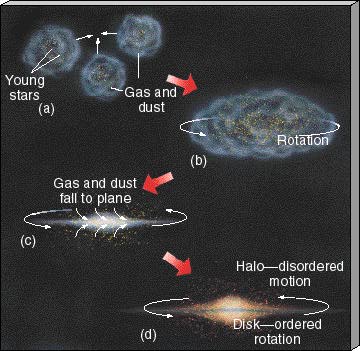Table 23.1 compares some key properties of the three basic components of the Galaxy. Is there some evolutionary scenario that can naturally account for the Galactic structure we see today? The answer is that there is, and it takes us all the way back to the birth of our Galaxy, 10—15 billion years ago. Not all the details are agreed upon by all astronomers, but the overall picture is now fairly widely accepted. For simplicity we confine our discussion here to the Galactic disk and halo. In many ways the bulge is intermediate in its properties between these two extremes.
| TABLE 23.1 Overall Properties of the Galactic Disk, Halo, and Bulge | ||||||||||||||||||||||||
|
Figure 23.14 illustrates the current view of our Galaxy's evolution, starting (not unlike the star-formation scenario outlined in Chapter 19) from a contracting cloud of pregalactic gas. (Sec. 19.1) When the first Galactic stars and globular clusters formed, the gas in our Galaxy had not yet accumulated into a thin disk. Instead, it was spread out over an irregular, and quite extended, region of space, spanning many tens of kiloparsecs in all directions. When the first stars formed, they were distributed throughout this volume. Their distribution today (the Galactic halo) reflects that fact—it is an imprint of their birth. Many astronomers believe that the very first stars formed even earlier, in smaller systems that later merged to create our Galaxy (Figure 23.14a); the present-day halo would look the same in either case.

Figure 23.14 (a) The Milky Way Galaxy possibly formed via the merger of several smaller systems. (b) Astronomers reason that, early on, our Galaxy was irregularly shaped, with gas distributed throughout its volume. When stars formed during this stage, there was no preferred direction in which they moved and no preferred location in which they were found. (c) In time, rotation caused the gas and dust to fall to the Galactic plane and form a spinning disk. The stars that had already formed were left behind, forming the halo. (d) New stars forming in the disk inherit its overall rotation and so orbit the Galactic center on ordered, circular orbits.
During the past 10—15 billion years, rotation has flattened the gas in our Galaxy into a relatively thin disk. Physically, this process is similar to the flattening of the solar nebula during the formation of the solar system, as described in Chapter 15, except on a vastly larger scale. (Sec. 15.2) Star formation in the halo ceased billions of years ago when the raw materials fell to the Galactic plane. Ongoing star formation in the disk gives it its bluish tint, but the halo's short-lived blue stars have long since burned out, leaving only the long-lived red stars that give it its characteristic pinkish glow. The Galactic halo is ancient, whereas the disk is full of youthful activity. The thick disk, with its intermediate-age stars, may represent an intermediate stage of star formation that occurred while the gas was still flattening into the plane.
The chaotic orbits of the halo stars are also explained by this theory. When the halo developed, the irregularly shaped Galaxy was rotating only very slowly, so there was no strongly preferred direction in which matter tended to move. As a result, halo stars were free to travel along nearly any path once they formed (or when their parent systems merged). As the Galactic disk formed, however, conservation of angular momentum caused it to spin more rapidly. Stars forming from the gas and dust of the disk inherit its rotational motion and so move on well-defined, circular orbits. Again, the thick disk's properties suggest that it formed while gas was still sinking to the Galaxy's midplane and had not yet reached its final (present-day) rotation rate.
In principle, the structure of our Galaxy bears witness to the conditions that created it. In practice, however, the interpretation of the observations is made difficult by the sheer complexity of the system we inhabit and by the many competing physical processes that have modified its appearance since it formed. As a result, the early stages of the Milky Way are still very poorly understood. We will return to the subject of galaxy formation in Chapter 24.